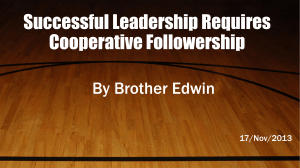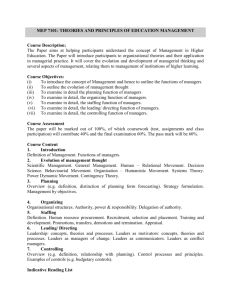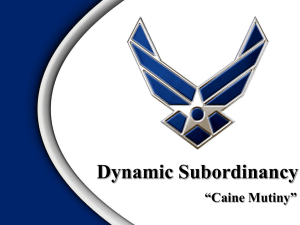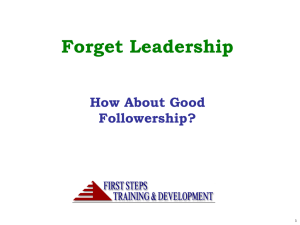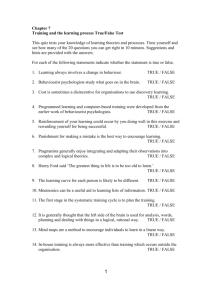Judy McKimm
advertisement
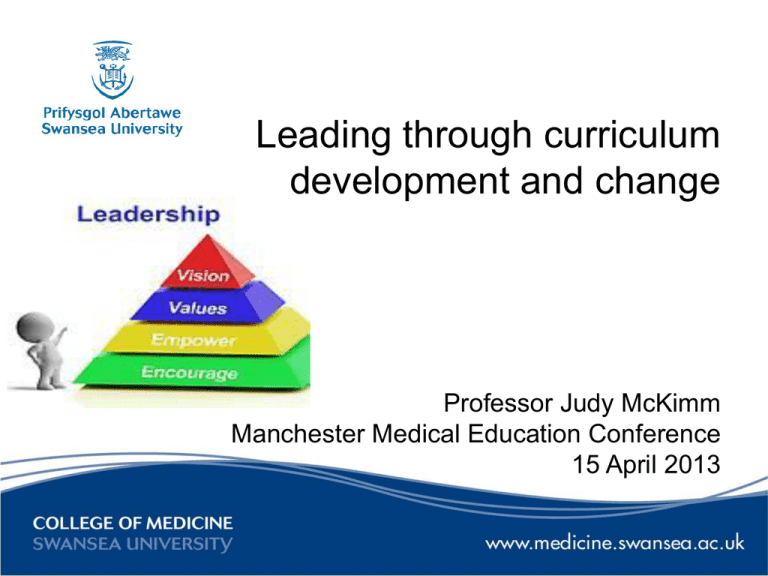
Leading through curriculum development and change Professor Judy McKimm Manchester Medical Education Conference 15 April 2013 • • • • • Context Leadership – what is it? What do leaders do? A little bit of theory Curriculum development and change Issues and challenges – strategies and solutions Changing leadership is needed for changing healthcare and educational contexts What is leadership*? * Google search 115,000,000 hits …. “Leadership is like the abominable snowman, whose footsteps are everywhere, but is nowhere to be seen” Bennis and Nanus, 1985 “if your actions inspire people to dream more, learn more, do more and become more, you are a leader” John Quincy Adams Leadership in Health Professions Educational leadership Leadership and management of organisations, departments, resources, research, projects, curricula, assessment, innovations Clinical leadership Leadership and management in the clinical setting, of teams, departments, units and of specific clinical situations Different contexts, ‘subject expertise’, content? But common themes •Leadership at ‘all levels’ - distributed, shared, dispersed •Leading professionals with high expertise •Leadership often invested in positional or professional power “Making change actually happen takes leadership. It is central to our expectations of the healthcare professionals of tomorrow “ Darzi, ‘Next Stage Review’,DoH, 2008 What is a leader? • ‘Someone with followers’ • Someone with vision, drive (‘energy, enthusiasm and hope’) • Guides/motivates groups, teams, organisations towards common goals • Is a good communicator, inspirational • Has perseverance, determination • Has integrity, can be trusted • Takes action, takes responsibility • Gives credit, gives praise How can theory inform practice? Leadership theories Adaptive leadership Engaging leadership Affective leadership Followership Authentic leadership Leader-member-exchange (LMX) theory Charismatic leadership, narcissistic Ontological leadership Phenomenological leadership Complex adaptive leadership Relational leadership Collaborative leadership Servant leadership Contingency theories Situational leadership Dialogic leadership Trait theory, ‘Great man’ theory Distributed, dispersed (shared) leadership Transactional leadership Eco leadership Transformational leadership Emotional intelligence (EI) Value led, Moral leadership Making sense of theories ... 1. Theories that focus on the personal qualities or personality of the leader as an individual 2. Theories relating to the interaction of the leader with others 3. Theories which seek to explain leadership behaviours in relation to the environment or system How does this help us? Building leadership capacity Bolden (2004) distinguishes between: • developing individual leaders (‘individual capital’) • developing ‘social capital’ through system wide approaches and capacity building Structured, programmatic development is most effective, workplace based, clearly aligned with curriculum or organisational goals and health needs What capacities are we building? • • • • • • • • Political ‘savvy’ Understanding the terrain Curriculum and educational expertise Leadership skills Change management Management skills Followership Team working Curriculum leadership and management Leadership – vision, ‘big picture’, strategies, non-technical/people skills, educational and organisational expertise, innovation/change Development of ‘phronesis’ (practical wisdom) in self and others Management – technical competencies and know how, operationalising vision/strategy, stability, standards, processes, procedures Leadership and followership “Innovation distinguishes between a leader and a follower” (Steve Jobs) No-one leads all the time Followers are very rarely passive, especially professionals. Kelley (1992) suggests four roles: – Passive followership – Active followership – ‘Little l’ leadership (leading in small ways, at all levels) – ‘Big L’ leadership present state unfreeze transition state refreeze Kurt Lewin (1951) desired future state Curriculum cycle Needs assessment Professional, organisational, individual Monitoring and evaluation Curriculum design Against stated learning outcomes and professional standards/competencies Approach, models, resources, teaching/learning/assessment methods Implementation Pilot, pre-test blog.rsc-wales.ac.uk The curriculum – 4 perspectives 1. Curriculum as a body of knowledge to be transmitted 2. Curriculum as an attempt to achieve certain ends in students - product 3. Curriculum as process 4. Curriculum as praxis Smith, M. K. (1996, 2000) 'Curriculum theory and practice' the encyclopaedia of informal education, www.infed.org/biblio/b-curric.htm. Shadow (hidden) curriculum • • • • • • Covert culture(s) Idiosyncrasies of individuals/groups/disciplines Hidden/informal organization Effects of social processes (internal and external) Impact of institutional politics/policies History, myths, beliefs, stories, rituals and routines adapted from Egan, G (1994) Working the Shadow Side: A Guide to Positive Behind-the-Scenes Management. New York: Wiley. The curriculum • ‘a politicised arena’ • ‘tribes and territories’ (Becher and Trowler, 2001) or a ‘jungle’ (Bolman and Gallos, 2011) • A vehicle for change Multi-frame perspective Bolman and Deal’s ‘Four frames’ (1997) Frame Metaphor Central concepts Structural Factory or machine Jungle Rules, roles, goals, policies, technology Family Needs, skills, relationships Temple or theatre Culture, meaning, ritual, ceremony, stories, heroes Political Human resource Symbolic Power, conflict, competition The political frame Curriculum as the place and space where different people and groups compete for power and resources Key leadership skills for the political frame • • • • • Agenda setting Mapping the political terrain Networking and forming coalitions Bargaining and negotiation skills Identifying common external enemies (and friends) A new health and education workforce? ‘Tempered radicals’ (Meyerson, 2004) ‘Broker, mediator and negotiator’ (Hartle et al, 2008; Tennyson and Wilde, 2000) ‘Boundary spanners’ (Bradshaw, 1999) Issues and challenges • Constant changes in education and health services • Working at the interface of health and education • Accreditation, professional standards, quality assurance, clinical governance • Structures, systems and funding often misaligned to curriculum innovation Strategies and solutions • Change is the only constant – leaders need to be comfortable with managing and leading change • Need for expertise in health and education systems – funding, structures, cultures • Understand and work within quality systems • Design agile, flexible curricula, in line with educational best practice and society’s needs Carnall C (1995) OLD CULTURE Hierarchical Paternalistic Bureaucratic Fixed boundaries Control Risk averse Managing change in organizations Prentice Hall NEW CULTURE Teamwork Connectivity Empowerment Trust Risk taking Innovation Support for action Why people resist change 1. 2. 3. 4. Parochial self-interest Misunderstanding Low tolerance of change Different assessments of the situation Kotter, JP and Schlesinger, LA (1979). Choosing strategies for change, Harvard Business Review, 106-114 Leaders as change agents Bennis (1984) identifies 4 competencies of leadership: • Management of attention (ability to communicate clear objectives and direction) • Management of meaning (creating and communicating meaning so that it is understood and people’s awareness is raised) • Trust (the ability to be consistent and clear in complex circumstances so that leaders are seen as dependable) • Self-awareness and the ability to work with one’s strengths and weaknesses Crises of followership • • • • Over-managing and bureaucracy A belief that only senior managers know best Isolating mavericks A belief that only a selected few factors in the external environment need to be addressed (missing complexity) Brown and Weiner (1984) Issues and challenges • Siloed working (professions, specialities, teams, organisations, gender) • Involves working with professionals, patients and students with different needs and demands • Top level leaders sometimes out of touch with educational change and innovation • Need to build up leadership/management capacity Strategies and solutions • Communication and networking between groups, professions, organisations – translational (‘sense making’) role • Work with stakeholders to meet and manage expectations and needs • Take time to keep up to date and inform others about innovation and change Leadership Theories in practice • • • • • • • • • • • • Great Man/Trait – personality is important Behaviourist – styles are important Transactional – links to reward, management Contingency, Situational – responding flexibly Distributive, shared – leadership at all levels Servant, value led – leaders as stewards Transformational - leaders as raising moral purpose Turnaround - leaders as change agents Collaborative – leaders as connectors Complex adaptive – leaders as change agents Congruent - relationships are important Holistic / Blended – all of the above! The servant-leader is servant first. It begins with the natural feeling that one wants to serve, to serve first. Then conscious choice brings one to aspire to lead (Greenleaf, 1970) Listening Awareness and sensitivity Stewardship Building a community Conceptualisation Healing Facilitation Foresight Persuasion not coercion Commitment to the growth of people Empathy The wise leader (Nonaka and Takeuchi, 2011) • Needs more than knowledge alone • Can practise moral discernment • Can sum up complex situations quickly and grasp key essence of problems • Creates the context for organisational learning • Communicates effectively • Exercises political power judiciously • Fosters development of practical wisdom in others Leaders are sense makers, expected to identify and articulate emerging themes and patterns not necessarily to have to have all the answers BUT be able to ask the right questions In summary • Leadership needs to be evidence based, theory informed, practice driven • Provide opportunities for active followership, “little ‘l’ leaders”, project champions – enable people to work to their strengths • Work collaboratively – share resources, actively succession plan, keep on top of current educational practice • Look outside medical education - make and develop cognitive/theoretical connections • Create flexible, agile curricula, use adaptive solutions to narrow the gap between aspiration and reality • Be willing to have fierce and hard conversations – ask ‘wicked’ questions • Find the balance between transformative change and maintaining stability through good management Thank you! Any questions? j.mckimm@swansea.ac.uk Developing teams and individuals “Leadership is not an esoteric topic relevant to a select few, but a ubiquitous feature of daily life for every physician” Gunderman, R, Leadership in healthcare, London: Springer-Verlag, 2009
